#echinoderm larva
Photo

Waterfleas carrying eggs
A Striking Short Film Documents the Otherworldly Organisms Living Just Beneath the Water’s Surface
With the aid of multiple microscopes, filmmaker and photographer Jan van IJken (previously) unveils the otherwise imperceptible maneuvers and bodily transformations of plankton. He focuses on a diverse array of underwater organisms, which all fall under the same taxonomy because of their inability to swim against the tides and are crucial to life on Earth, providing half of all oxygen through photosynthesis. Set against black backdrops, the marine drifters appear otherworldly in shape and color, and the filmmaker documents water flea eggs visible through translucent membranes, the spiked fringe of cyanobacteria, and the minuscule movements of various creatures as they wriggle across the screen.
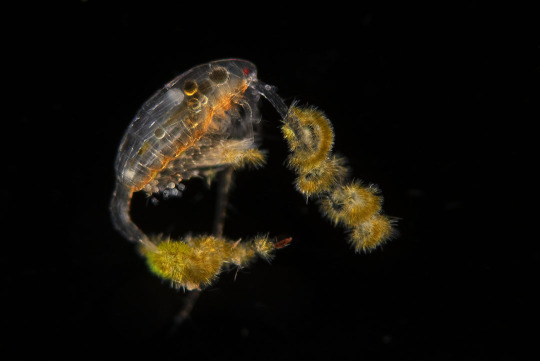
Copepod with diatoms attached

Echinoderm larva

Gloeotrichia – Cyanobacteria
#jan van ijken#photographer#filmmaker#microscopes#short film#organisms#plankton#nature#cyanobacteria#waterfleas#copepod#echinoderm larva#gloeotrichia
31 notes
·
View notes
Text
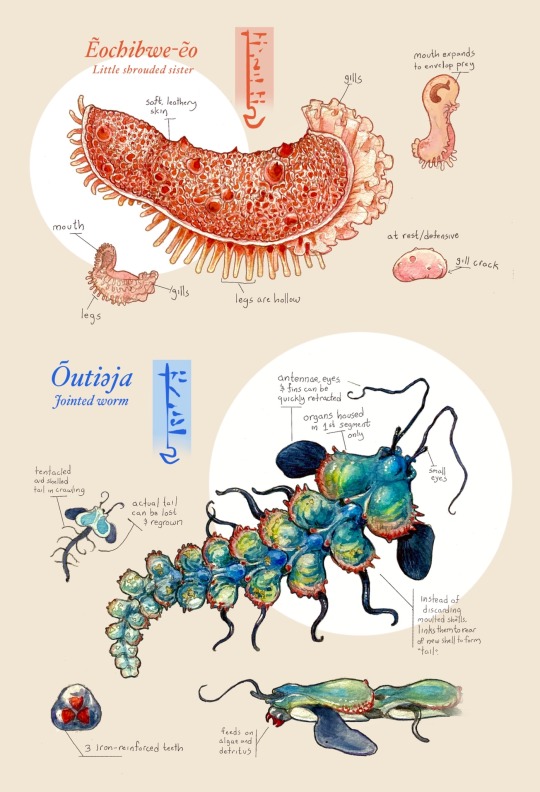
Illustrations and notes on two small invertebrate animals found along the Twowi coastline.
The first is a soft bodied creature from a diverse family of benthic invertebrates characterized by lack of eyes, echinoderm-like tube feet, and an ability to generate copious amounts of mucus from the dermis. Affectionately referred to as “little shrouded sister” in the local language, this creature is a rare but handsome find in the bottom of deep pools during Twin Moon tides, when the water recedes the furthest. It defends itself from predators with acrid tasting toxins in the mucus coating its “shroud”, which are released within seconds of being attacked. According to local legend, they are born of unfed larvae thrown into the sea, which survived by latching onto the backs of fish.
The second is a shelled animal whose name means “jointed worm”, though another common moniker is the “mud-rattle”. It gets this name from its peculiar shell, which links to each previous molt to form a long, articulated tail reminiscent of a rattlesnake’s. However, this armored tail carries no warning; it is simply an eye-catching distraction. As long as the vital organs in the first segment remain unharmed, this worm can live to grow another tail. They inhabit muddy sea floors across a wide swath of the world’s oceans, and range in size from just 2 cm to more than a meter. Ease of collection and tender flesh make this creature a popular seafood; boiled, steamed, or fried; it is arguably the “shrimp” of birg cuisine. The handsome shells are also commonly re-articulated for a second life as rattles and jewelry.
________
Also available as a print!
Patreon | Kofi
789 notes
·
View notes
Text
Wet Beast Wednesday: brittle stars
Some animals end up living in the shadows of others. Everyone knows about starfish, the famous branching echinoderms, and a lot of people know about brittle stars, but not as many people know that brittle stars aren't starfish, they're their own thing. But because they look similar, brittle stars are frequently mistaken for a type of starfish, rather than being recognized as their own animal. I aim to help these stars shine and be recognized as their own animal.

(Image ID: a green brittle star on a rock. It consists of a small, round central body with five long, slender arms arms emerging from it at equal distances from each other. Thea rams are lines on either side with small bristles. End ID)
Brittle stars are members of the class Ophiuroidea, which is closely related to Asteroidea, the true starfish. The name comes from the Greek "ophis", meaning "serpent", a reference to their long, skinny arms. Ophiuroidea is divided into two orders, Ophiurida (true brittle stars) and Euryalida (basket stars). As with all echinoderms, brittle stars are radially symmetrical, consisting of multiple body segments that radiate around a point, akin to the slices of a pizza. The majority of brittle star species have five segments, though a few have six or more. Similarly to starfish, brittle stars have their arms radiating out from a central disc. In brittle stars, all the organs are located in the disc and as long as the disc remains intact, the arms can be regrown. The mouth (which also functions as the anus) is located in the center of the disc and each body segment has a single jaw and tooth. Some starfish can regenerate into two animals if the disc is cut in half, but almost no brittle stars can survive being cut in half. That being said, some species can reproduce via fission, where the disc splits in half and each half regenerates into a fully-grown star. In brittle stars, the arms are narrower than the disc, making the disc much more visually distinct than in starfish, where it can be hard to tell where the disc ends and arm begins. The arms of a brittle star are slender and highly flexible. When in danger, a brittle star can sever one of its arms. This is usually done in response to predation, in hopes that a predator will opt to eat the arm while the star makes its escape. This is called autotomy and is the reason why the common name of these animals is brittle star. The arms are formed of multiple calcium carbonate plates called vertebral ossicles due to their resemblance to vertebrae. The ossicles are connected to each other by ball and socket joints, allowing for a great degree of flexibility. Most true brittle stars can flex their arms side to side, but not up and down, while basket stars can flex in all directions. In basket stars, the arms branch multiple times. Unlike starfish, brittle stars use their arms for locomotion. The arms move in a rowing motion to drag the star around. Some species can swim for short distances as well. By contrast, starfish (and urchins) move using tube feet. Tube feet are a common echinoderm trait and consist of small tubes with a sucker on one end that are inflated and moved with water pressure. Most echinoderms use their tube feet for movement and feeding. True brittle stars, by contrast, seem to use their tube feet primarily for sensory reception, though they are also used to help transport food to the mouth. Due to moving with their arms instead of tube feet, brittle stars are capable of much faster movement than starfish, though in short bursts. Like other echinoderms, brittle stars use a water vascular system, where water is drawn into the body and used to inflate and move the tube feet and as a substitute for blood. Brittle star reproduction is fairly standard for echinoderms. The males and females will release their gametes into the water column. Fertilized eggs develop into pluteus larvae, which swim using cilia. In the pluetus stage, echinoderms are bilaterally symmetrical. They become radially symmetrical during metamorphosis into the juvenile form.

(GIF ID. A pale white brittle star swimming by rapidly moving its legs. End ID).
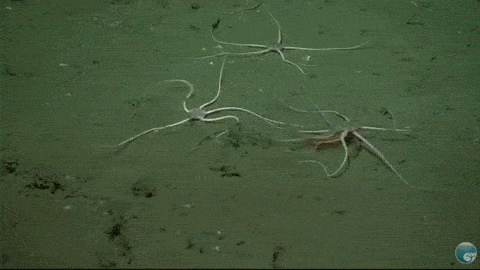
(GIF ID: two white brittle stars (with a third in the background) moving across sand by using their legs to push and drag themselves along. One appears to be carrying a red object in its mouth. End ID)

(Image ID: a basket star on a rock. The central disc in brown and has a pair of arms emerging from each segment. Each arm branches repeatedly and those branches have their own branches, resulting in a vaguely bush-like appearance. End ID)
Brittle stars are eyeless, but can detect light. Most animals, and a lot of non-animals, have some ability to detect the presence or absence of light. True vision, the ability to form images, requires more complex systems than the might-sensing cells most animals have. More specifically, it requires an eye. Or at least that's what we thought until scientists found evidence that the brittle star Ophiomastix wendtii may be able to form imaged without an eye by using its whole body as one big eye (a sea urchin, Diadema africanum) also seems to have this ability). Brittle stars are covered with light-sensing structures called opsins that can detect the presence or absence of light, but vision-forming sight requires the ability to determine how much light is coming from what direction. O. wendtii uses chromatophores to alter its color and these packets of pigment-changing cells are arranged in such a way that they may provide that directionality. In tests, O. wendtii would travel to shelter when exposed to light with a greater than change likelihood while the closely-related O. pumila would move at random when exposed to light. O. pumila lacks the types of pigment that O. wendti has, which could prevent it from being able to form the directionality needed for vision-forming sight. This is reflected in the species' behavior. O. wendtii moved toward shelter when exposed while O. pumila prefers to bury itself. The possibility for vision to exist without eyes means that a lot of animals we previously thought of as blind may actually be able to see, though probably not as well as animals with eyes.
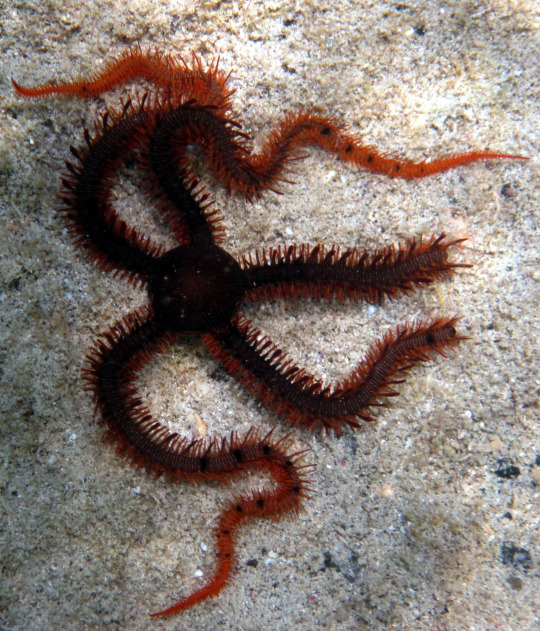
(Image ID: Ophiomastix wendtii, a red brittle star with larger bristles on its legs. Two legs are shorter and blunted, possibly having been damaged. End ID)
There are over 2,000 known species of brittle star that live all over the oceans, from shallow water to the deep sea. Most basket stars are seep-sea animals, though some shallow-water species are known. True brittle stars are mostly detritivores who crawl along sediment and eat bits of organic matter and tiny organisms. This behavior makes them seafloor engineers. Their feeding behavior stirs up the sediment, releasing nutrients and affecting the behavior of other species that rely on the sediment. Because of this, brittle stars are often highly important parts of their ecosystems. Some species follow different lifestyles. Some will target and eat sponges or coral polyps while others are active predators of small animals, filter feeders, or even omnivores that eat plant matter. Brittle stars often live in or on corals or sponges, which provide a source of protection. The relationship between star and coral or sponge may be symbiotic in some species, with the star eating parasites and pests that endanger its host. Basket stars are filter feeders that use their many branching arms to catch plankton. They need to live in places with a current as as such are often foudn on seamounts, where the underwater mountain directs the flow of water into currents. The star anchors itself to a rock, coral, or other surface and extends its arms into the current to make a net. The arms are lined with tiny hooks that catch plankton carried by the flowing water. Once caught, tube feet cover the plankton with mucus and transport it slowly to the mouth. The star will sometimes bring its arms to its mouth to speed up the process. When threatened, basket stars will bring in their legs and form a ball to protect the disc. Basket star arms are less muscular than those of true brittle stars and therefore they are not as fast. Basket stars generally get bigger than true brittle stars, with the largest species, Gorgonocephalus eucnemis, having a disc up to 14 cm (5.5 in) in diameter and an arm length of up to 70 cm (27.5 in).

(Image ID: a pale red brittle star with no bristles on its arms. It is climbing sea fan (type of coral with appearance similar to a fern), with its arms wrapped around the coral for stability. End ID)
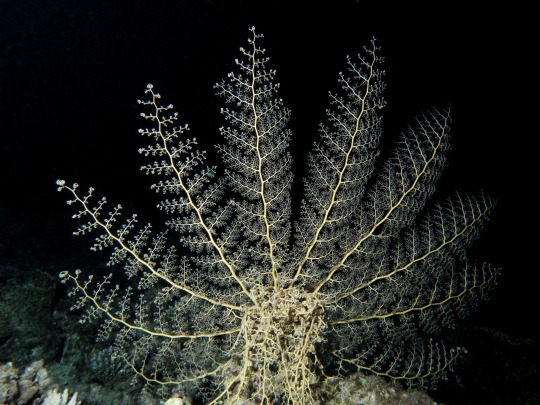
(Image ID: a basket star in feeding posture. It is on a rock with some of its arms used to support it. The rest of the arms are extended into the water column, with every branch fully extended. It looks kind of like pale white ferns. End ID).
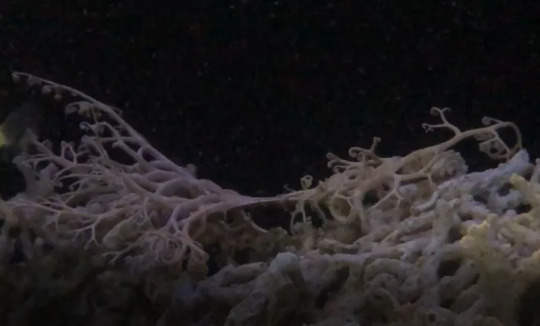
This basket star living in the St. Lucie County Aquarium in Ft. Pierce, Florida ripped itself in half shortly after being introduced to the exhibit. Esch half survived and regenerated into a full basket star. This is the only time this behavior has been seen in this species (Astrophytum muricatum). Of course, trying to rip yourself in half is a reasonable response to realizing you have to live in Florida.
(Image ID: a white basket star splitting into two halves, each with a portion of the arms. The only thing connecting the halves is a small strip of tissue. End ID)
#wet beast wednesday#brittle stars#basket stars#echinoderm#marine biology#marine life#animal facts#zoology#biology#ecology#pictures#image described
178 notes
·
View notes
Text
Strange Symmetries #03: Eerie Early Echinoderms
Represented today by starfish, brittle stars, sea urchins, sea cucumbers, and crinoids, the echinoderms have a characteristic five-way radial symmetry that makes them barely even recognizable as bilaterians. Their true ancestry is only revealed by their genetics and their larvae, which still retain bilateral symmetry – and the way they metamorphose into adults is bizarre, essentially growing a whole new radial body from within the left side of their larval body.
(Sea cucumbers and sand dollars are superficially bilateral as adults, but evolved this secondarily on top of their existing radial symmetry. And some adult echinoderms like starfish also seem to retain a little bit of "behavioral bilaterism", generally preferring to move with a specific arm always acting as their "front" end.)
The first known echinoderms appeared in the fossil record during the early Cambrian, about 525 million years ago, but the common ancestor of the whole group probably actually originated a few tens of millions of years earlier in the mid-to-late Ediacaran. Early echinoderms seem to have started off as flattened animals that sat on the seafloor filter-feeding, and with this largely immobile way of life their bodies started to shift into asymmetry, no longer constrained by the locomotory advantages of being bilaterally symmetric.
In fact, for these early sedentary filter-feeders being radial was actually much more advantageous, able to distribute sense organs all around their bodies and grab food from any direction without having to reposition themselves, converging on the lifestyle of non-bilaterian cnidarian polyps. The evolutionary transition from bilateral to asymmetrical to pentaradial seems to have happened incredibly quickly during the Cambrian Explosion, and all modern echinoderms probably evolved from a group called the edrioasteroids, maintaining their new base body plan even when they later began taking up more mobile lifestyles again.
But during the process of all that some very alien-looking lineages split off at various stages of anatomical weirdness.
Stylophorans had asymmetrical bodies with a single feeding arm at the front, and varied from irregular boot-like shapes to almost bilateral heart shapes depending on their specific ecologies. The highly asymmetrical forms were probably spreading their weight out over soft soupy mud in quiet waters, while the more bilateral forms may have been more streamlined to deal with stronger water currents.
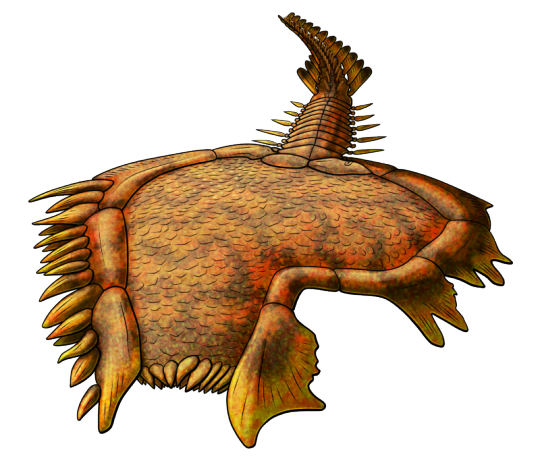
Sokkaejaecystis serrata was a stylophoran that lived during the late Cambrian, about 501-488 million years ago, in what is now South Korea. It was tiny, only about 1cm long (~0.4"), and its boot-shaped body was surrounded by spines and flanges that spread out its surface area and probably also made it much more awkward for small predators to attempt to eat.
———
Meanwhile the solutes started off as immobile animals living attached to the seafloor via a stalk-like appendage. But fairly early in their evolution they switched to a more active mode of life, modifying their stems into tail-like "steles" that were used to push themselves along.
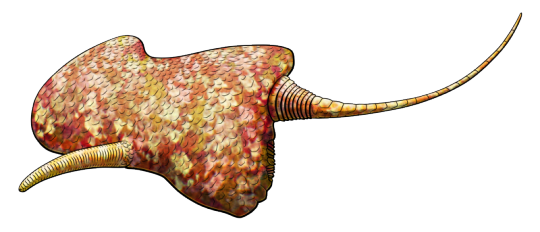
Maennilia estonica lived in what is now Estonia during the late Ordovician, about 450 million years ago. It was quite large for a solute at about 12cm long (~4.7"), with a sort of vaguely-trapezoidal body, a short feeding arm, and a long thin stele.
Both of these strange early echinoderm lineages were surprisingly successful, surviving for a good chunk of the Paleozoic Era alongside their more familiar radial relatives. The solutes lasted until the early Devonian about 400 million years ago, and the stylophorans continued all the way into the late Carboniferous about 310 million years ago.
———
NixIllustration.com | Tumblr | Twitter | Patreon
#science illustration#strange symmetries#paleontology#paleoart#palaeoblr#sokkaejaecystis#stylophora#maennilia#soluta#echinoderm#ambulacraria#deuterostome#bilateria#art#eldritch echinoderms#go home evolution you're drunk
506 notes
·
View notes
Photo

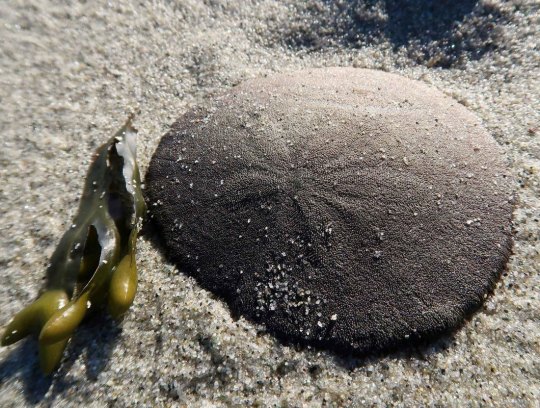
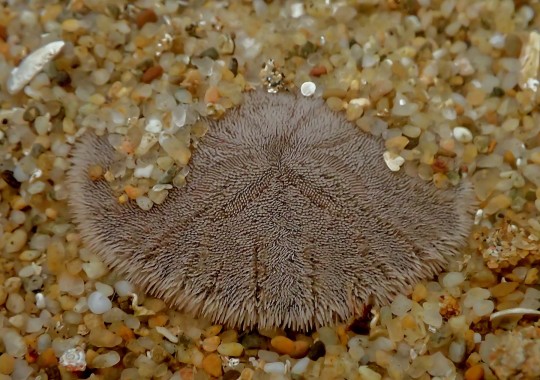
Another Day, Another Pacific Sand Dollar
The eccentric sand dollar, aka the sea-cake, biscuit-urchin, western sand dollar, or Pacific sand dollar (Dendraster excentricus), are found in the intertidal zone and near-shore sandy bottoms from Alaska, US to Baja California, Mexico.They are the only sand dollars endemic to the Pacific Northwest, though they share the rest of their range with other species. Live individuals are seen either partially buried upright or lying flat on the ocean floor, depending on the strength of the current. To prevent themselves from being swept away, juveniles will also ingest sand to weigh themselves down. Although they are not social, they can form large colonies with as many as 6 sand dollars in a square m (1 sq yd).
Pacific sand dollars are named for their resemblance to silver dollars, especially the bleached exoskeletons that commonly wash up on beaches. Most adults average about 8 cm (3 in) across, though individuals as big as 10 cm (4 in) have been found. The body is a flat disc coated in small, purple tube-like feet and sensory organelles called cilia. The feet are used both for moving across the ocean floor and for pulling oxygen from the water. The mouth and anus-- a single opening-- are located on the sand dollar’s underside. Inside the mouth are five teeth and jaw plates known as doves; together they form a structure known as Aristotle’s lantern, which is unique to echinoderms like sand dollars and sea stars.
D. excentricus is a suspension feeder, using its feet and cilia to pull food from the water or direct it along special groves on the body’s underside. Their main prey are microscopic larvae, copepods, diatoms, algae, plankton, and detritus. The sea-cake is predated upon by a number of sea stars and fish, as well as crabs and sea gulls. To avoid being eaten, adults bury themselves in the sand and larvae will duplicate themselves via a process known as budding and fission, which creates smaller individuals that can distract potential predators.
Although western sand dollars have seperate sexes, they are broadcast spawners. In late spring or early summer, males and females congregate and release gametes into the water where they become fertilized. Larvae, also known as prisms, hatch just a day later. This larvae floats freely through the water, growing arms and metamorphosing into a echinopluteus larva. Once they reach 8 arms, the larva begins to develop an exoskeleton or echinus, and resembles a small adult. The final stage of growth is triggered by chemical cues released by other adults; after this, individuals become sexually mature and settle on the ocean with other sand dollars. In the wild, adults can live up to 13 years.
Conservation status: Although the IUCN has not evaluated the Pacific sand dollar, they are regularly threatened by ocean acidification, warming, and bottom trawling.
If you like what I do, consider leaving a tip or buying me a ko-fi!
Photos
Chan Siuman
Brian Starzomski
Alison J. Gong
#pacific sand dollar#Clypeasteroida#Dendrasteridae#sand dollars#echinoderms#invertebrates#marine fauna#marine invertebrates#benthic fauna#benthic invertebrates#intertidal zone#intertidal invertebrates#coasts#coastal invertebrates#Pacific Ocean#North America#western north america
374 notes
·
View notes
Text
*Nope (movie) spoilers ahead!!!*
I will now post my rambles about the various similarities Jean-Jacket has with with the phylogenetic group of Echinodermata.
It seems obvious that Jean jacket is inspired by some kind of sea life. The very way it moves, swimming around the sky.
Many have compared its final form to jellyfish or something similar, and while I do not disagree, I would like to propose something different.
First of all, let me explain what Echinoderms are.
Echinodermata is a biological group, including starfish, brittle stars, sea urchins, sand dollars, sea cucumbers and sea lilies.
Now to the similarities:
UFO stage:
Jean Jacket feeds 2 ways.
One: it sucks in air, along with whatever debris and/or food comes with
This is also something a lot of marine species do! It’s called filter feeding.
This feeding tactic is also what sea urchins do! They filter through the central hole:
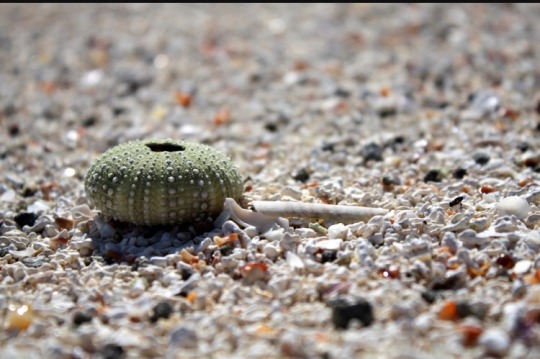
See the similarities?
Now you might think: well, that’s not really how Jean-jacket looked.
Well, how about this?
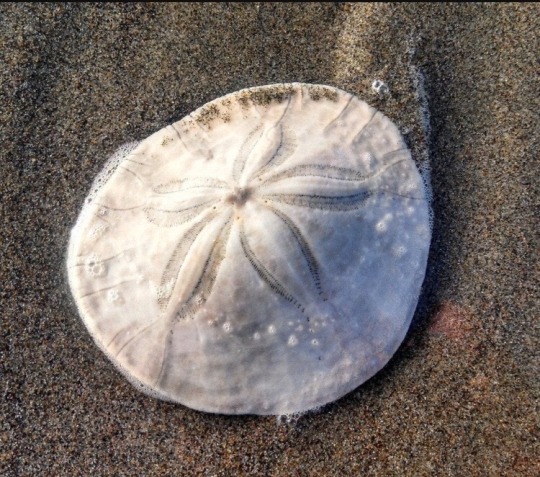
Looks a bit closer, doesn’t it? That’s a sand dollar, although a dead one. But that’s what most people picture when they think of one.

Here another picture, for reference. As well as a very good example of Jean jacket filter feeding.
Okay, now to move on to Jean jackets other form. Wether that was supposed to be a sort of ‘evolution’, or something it did because it was angry/threatened, I don’t know.
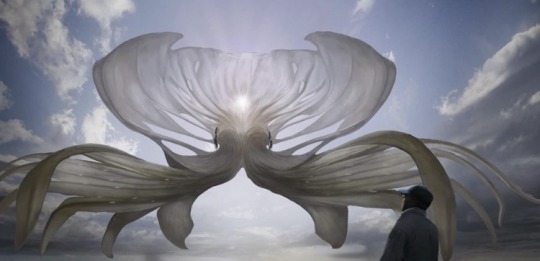
Here it is!
Now, a different group of Echinodermata, the feather stars.

See some similarities? (Also please not how damn cool feather stars are)

Here, have another because I adore them.
But alas, I have more than mere comparison of physique!
The hunting strategy!
Of course, for marine species, it is very popular to do what Jean-jacket is doing. Floating around safely, and swooping down to the ground to devour pray, who may not get away fast enough, or be able to get away at all.
So that is not very specific for the group I am about to mention, although they sure do it.
No, what I mean is way number 2 that Jean jacket eats what it considers prey.
Sadly I am unable to find a screenshot, but in it’s final form, trying to eat the giant cowboy ballon, Jean jacket envelops it while simultaneously shoving it towards its central hole.
You know who else does that?
Fucking sea stars!
Because they have a really cool thing called a cardiac stomach.

Basically, they can eject it, and envelope larger prey, to either pull inside, or digest outside of its body cavity.
(It can also use it to slip into a crack in a imperfectly closed mussel shell, and slurp the terrified prey right out, which I must say is quite the power move)
As you might notice, most of the sea creatures I have shown you pictures of poses radial symmetry. Actually, it is penta radial symmetry, which may be hard to notice in some though.
While I cannot see any markings on Jean Jackets UFO form that could confirm or debunk the idea of penta radial symmetry, the radial symmetry part sure seems to fit.
But Charlie, you might say, the last stage of Jean Jacket seemed to have a clear front and back. Doesn’t that mean it possesses bilateral symmetry?
Yes! You are right! It seemed to have its body opening at the ‘front’

First of all, there is something about the symmetry of Echinodermata that you should know.
Yes, they are penta radially symmetric, but they haven’t always been.
They have actually secondarily lost their bilateral symmetry in the adult stage, but their larva still have it.
Meaning that it is not too far off to assume a different stage of Jean jacket might have a different symmetry as well.
But that aside, I want to show you another group, or more a specific species from that group that has some stunning similarities.
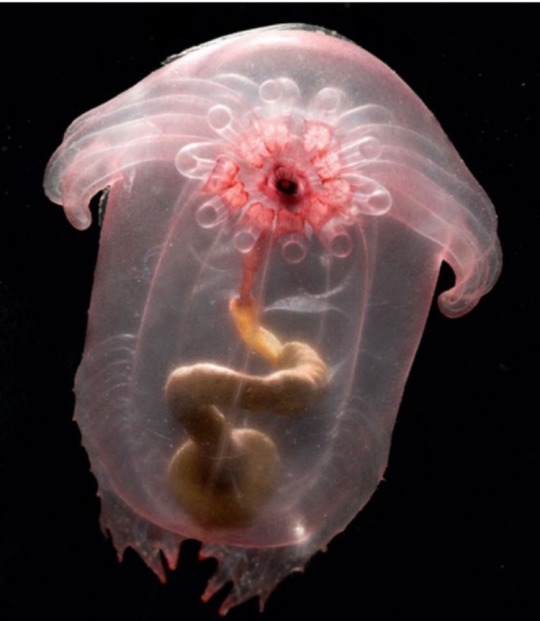
This specific deep-sea sea cucumber.
I rest my case. I think it’s clear that the creators have either knowingly or unknowingly created a lot of similarities and parallels between Jean Jacket and the Echinoderms.
As you can see I am very excited about that.
#nope movie#long post#listen I know this is useless but it was fun sooo#echinoderms#Echinodermata#should I tag this as autism? lol. cos I think it might count#XD#marine biology#Jean jacket#Jean jacket nope#nope spoilers#nope 2022#listen i know the filmmaker admitted its about jellyfish but let a guy dream
63 notes
·
View notes
Text
Examples of Metamorphosis
Tadpole, an aquatic larval stage that transforms into the land-dwelling frog (class Amphibia).
Starfishes and other echinoderms undergo a metamorphosis that includes a change from the bilateral symmetry of the larva to the radial symmetry of the adult.
Metamorphic patterns are well-known in crabs, lobsters, and other crustaceans and also in snails, clams, and other mollusks.
Among the most dramatic and thoroughly studied examples of metamorphosis are the insects
Because development is not the same in all insects, it is convenient to group them into major categories according to the pattern of structural changes: ametabolous, hemimetabolous, and holometabolous. In ametabolous development there is simply a gradual increase in the size of young until adult dimensions are attained. This kind of development occurs in the:
Silverfish, springtail and other primitive insects.
Sorungtail
Other primitive insects
In more advanced insects, for example:
Grasshoppers
Termites
True bugs
A phenomenon known as gradual, or hemimetabolous, metamorphosis occurs.
The hemimetabolous life cycle consists of egg, nymph, and adult
The nymph, or immature insect, resembles the adult in form and eating habits, differing in size, body proportions, and colour pattern. Rudimentary wings are visible and develop externally. Development is gradual through a series of molts (periodic shedding of the outer skeleton), the adult emerging from the final molt.
Complete, or holometabolous, metamorphosis is characteristic of:
Beetles
Butterflies
Moths
Flies
Wasps
Their life cycle includes four stages: egg, larva, pupa and adult. It is wingless, and it’s form and habits are suited for growth and development rather than reproduction. The change to the adult occurs during the inactive, no feeding pupal stage. At this time the larva undergoes a transformation in which the wings appear externally, larval organs and tissues are broken down, and adult structures are developed.
Harvard Referencing:
BRITANNICA. (2024) Metamorphosis | Insect Development, Adaptation & Evolution. [Online] Available from: https://www.britannica.com/science/metamorphosis [Accessed: 23rd February 2024]
2 notes
·
View notes
Note
can you tell me a fun ocean fact
omg yes I would love to. Brittle stars, like the one thats my pfp, are unique among echinoderms bc they brood their young! the other guys, like many marine species, are broadcast spawners. this means they just dump their cum in the ocean and hope for the best, leaving larvae to grow into babies and develop all by themselves. brittle stars on the other hand carry their little babies!


image source
brittle stars are also unique in that they evolved to loose their anus so they poop out of their mouths lol
#i hope this stuff is accurate im doing this from memory from a class i took 2 years ago lol. so sorry if im wrong#asks#mistress-of-the-wicket#bio blogging
9 notes
·
View notes
Text
Animal Crossing Fish - Explained #222
Brought to you by a marine biology who's got a gold star!
CLICK HERE FOR THE AC FISH EXPLAINED MASTERPOST!
It's about damn time we had another sea star! Remember when I talked about the sea star in ACNH and mentioned that sea stars as a group are magical little monsters? If not, go back and read up, because we're expanding on that. Today's star is the Northern Pacific Sea Star!

Okay, that's not actually what it's called in the games. In AC Pocket Camp, this guy is just called "Yellow Starfish". (And yes, I hate it, because Sea Stars aren't fish, but I digress...) I'm sure it and the two other color stars it showed up with during the Starry Fishing Tourney in December 2019 were just your generic sea stars in different colors, but we all know I don't accept that. The Northern Pacific Sea Star (Asterias amurensis) really fits the bill here, though. It is native to Japanese waters, is a medium-sized sea star, and...comes in this color. So, for all intents and purposes, I'm going to use this and the other stars from Starry to introduce some sea stars.
So, since it's been over 100 entries since we talked about sea stars, let's get back to basics for a sec. Sea Stars are probably the most famous and beloved members of the Echinodermata, a Phylum of animals that are truly aliens, but are actually closely related to Chordates, which includes us vertebrates. Adults of the phylum are best known for their radial symmetry, tube feet powers by a water vascular system, and a hard inner-skeleton made with calcium. It's a lot to take in, because these animals are so weird. The Northern Pacific Sea Star - NPSS - is a member of Asteroidea, the Class of Sea Stars.

Photographer: Mark Norman, Museums Victoria
https://collections.museumsvictoria.com.au/species/8742
The NPSS is also an invasive species. As the name says, they are native to the Northern Pacific Ocean, hanging out on the sea bottom all around Japan, Korea, and Russia, and spans across to Alaska and Canada. Unfortunately, they are also found in the South Pacific near Australia and Tasmania where they have been accidently introduced. They are predators with an endless appetite for bivalves like mussels and clams, much to the ire of the human population. They are on the list of the world's worst 100 invasive alien species. Unlike a few invasive animals we've talked about on the AC Fish Explained, this one was a complete accident, as many invasive species are. With mobile, planktonic larvae, it's easy for things like sea stars to spread by hitching a ride on or in ships making trans-oceanic voyages.
So, yeah, it didn't walk to Australia, but now that it's settled in, it sure gets around eating up bivalves. Like I mentioned before, echinoderms have tube feet powered by a water vascular system. This is a fascinating bodily system that aids echinoderms in locomotion using hydraulic, aka water, pressure. Seawater is brought into the animal via a pore on the central disc, and feeds that water through a series of canals that bring the water into the arms. Once there, muscles force the water into their tube feet, which makes them expand. Relaxing the muscle makes them shrink. They look like this:

By CSIRO, CC BY 3.0, https://commons.wikimedia.org/w/index.php?curid=35441998
It's a super slow process, but it gets the job done. Sea stars don't really need to move all that quickly. For the NPSS, its prey is sessile, meaning it typically doesn't move from its spot, and if it does, it's also quite slow. On the other side of things, not many things want to eat the NPSS except for bigger sea stars. Considering the NPSS grows to 50 cm in diameter, it's not a small animal to be overpowered.
And there you have it. Fascinating stuff, no?
#Northern Pacific Sea Star#sea star#starfish#animals#echinoderms#animal crossing#animal crossing pocket camp#acpc#marine biology#science in video games#animal crossing fish explained
3 notes
·
View notes
Text
Worms are many different distantly related bilateral animals that typically have a long cylindrical tube-like body, no limbs, and no eyes (though not always).
Worms vary in size from microscopic to over 1 metre (3.3 ft) in length for marine polychaete worms (bristle worms);[1] 6.7 metres (22 ft) for the African giant earthworm, Microchaetus rappi;[2] and 58 metres (190 ft) for the marine nemertean worm (bootlace worm), Lineus longissimus.[3] Various types of worm occupy a small variety of parasitic niches, living inside the bodies of other animals. Free-living worm species do not live on land but instead live in marine or freshwater environments or underground by burrowing.
In biology, "worm" refers to an obsolete taxon, Vermes, used by Carolus Linnaeus and Jean-Baptiste Lamarck for all non-arthropod invertebrate animals, now seen to be paraphyletic. The name stems from the Old English word wyrm. Most animals called "worms" are invertebrates, but the term is also used for the amphibian caecilians and the slowworm Anguis, a legless burrowing lizard. Invertebrate animals commonly called "worms" include annelids (earthworms and marine polychaete or bristle worms), nematodes (roundworms), platyhelminthes (flatworms), marine nemertean worms ("bootlace worms"), marine Chaetognatha (arrow worms), priapulid worms, and insect larvae such as grubs and maggots.
Worms may also be called helminths—particularly in medical terminology—when referring to parasitic worms, especially the Nematoda (roundworms) and Cestoda (tapeworms) which reside in the intestines of their host. When an animal or human is said to "have worms", it means that it is infested with parasitic worms, typically roundworms or tapeworms. Lungworm is also a common parasitic worm found in various animal species such as fish and cats.
In taxonomy, "worm" refers to an obsolete grouping, Vermes, used by Carl Linnaeus and Jean-Baptiste Lamarck for all non-arthropodinvertebrateanimals, now seen to be polyphyletic. In 1758, Linnaeus created the first hierarchical classification in his Systema Naturae. In his original scheme, the animals were one of three kingdoms, divided into the classes of Vermes, Insecta, Pisces, Amphibia, Aves, and Mammalia. Since then the last four have all been subsumed into a single phylum, the Chordata, while his Insecta (which included the crustaceans and arachnids) and Vermes have been renamed or broken up. The process was begun in 1793 by Lamarck, who called the Vermes une espèce de chaos (a sort of chaos) and split the group into three new phyla, worms, echinoderms, and polyps (which contained corals and jellyfish). By 1809, in his Philosophie Zoologique, Lamarck had created 9 phyla apart from vertebrates (where he still had 4 phyla: mammals, birds, reptiles, and fish) and molluscs, namely cirripedes, annelids, crustaceans, arachnids, insects, worms, radiates, polyps, and infusorians. Chordates are remarkably wormlike by ancestry.
1 note
·
View note
Photo

Taken the same day as the previous post, this is a common sunstar (Crossaster papposus), or solstjärna, caught in the fjord and is feasting on an unfortunate tall sea pen. In Sweden, they occur on the west coast on hard, sandy or gravelly bottoms within 10-50 m depths. For sessile and slow-moving invertebrates, these 35mm in diameter beasties are vicious predators that travel 35-50 cm a minute and will even devour other sea star. Before they become the predator shown here, they start out life during the late spring as free-swimming larvae for a short period that feed on nothing as they swim in groups before settling to the bottom. #animal #animals #djur #wildlife #natur #naturliv #nature #fauna #invertebrate #invertebrates #seastar #seastars #sjöstjärnor #sjöstjärna #asteroid #asteroids #sunstar #sunstars #echinoderm #echinoderms #tagghudingar #animalia #echinodermata #asteroidea #valvatida #solasteridae #crossaster #crossasterpapposus #commonsunstar #solstjärna (at Klubbans biologiska station) https://www.instagram.com/p/CeG-NS8K06Q/?igshid=NGJjMDIxMWI=
#animal#animals#djur#wildlife#natur#naturliv#nature#fauna#invertebrate#invertebrates#seastar#seastars#sjöstjärnor#sjöstjärna#asteroid#asteroids#sunstar#sunstars#echinoderm#echinoderms#tagghudingar#animalia#echinodermata#asteroidea#valvatida#solasteridae#crossaster#crossasterpapposus#commonsunstar#solstjärna
0 notes
Note
Are the "eggs with legs" a direct product of the birg's body (like a chicken's egg), or is it weirder/more complicated than that?
Yes and yes…? Like an egg, the “tick” is produced by the birg’s body and can exist even without fertilization (though like a chicken’s egg, an unfertilized tick will never produce another birg)
I think of them as another form of an alternating life cycle, something between what happens with the feathervanes (and irl ferns and kelp) and the way that some echinoderms (starfish and kin) begin life as bilateral larvae that are torn apart by the growing pentaradial juvenile.
107 notes
·
View notes
Text
It's too bad Halloween was yesterday because I would have done a Wet Beast Wednesday on something creepy, like the tongue-biting isopod. It's not though, so so I'm dipping my toes into echinoderm science and talking about crinoids. While crinoids are the least famous echinoderms, being overshadowed by their relatives the starfish, sea urchins, and sea cucumbers, they are extremely well-represented in the fossil record. We know of far more extinct crinoid species than living ones.
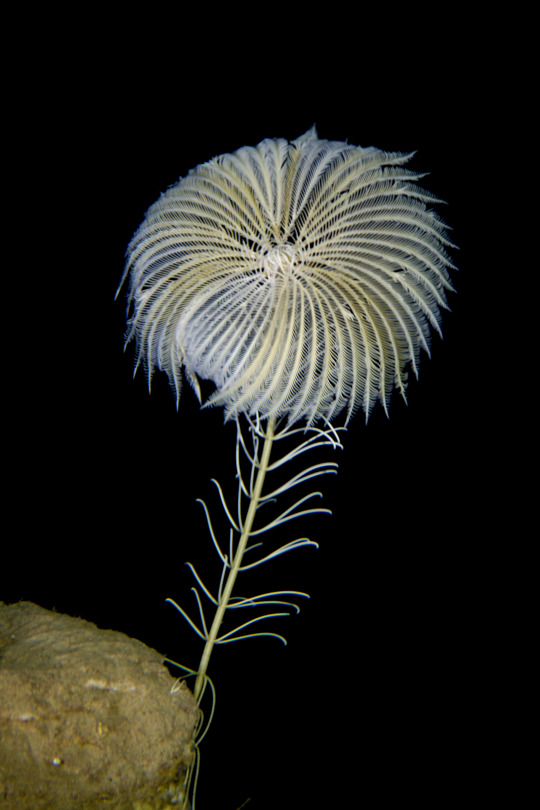
(imag id: a crinoid attached to a rock. It is a long, slender stalk with multiple threadlike protrusions emerging from it. At the top is a crown that looks like a flower composed of feathery appendages. It is while all over)
As with all echinoderms, crinoids are bilaterally symmetrical as larvae for become radially symmetrical while adults. It is hypothesized that the ancestor of all echinoderms was a bilaterally symmetrical animal that evolved to become radially symmetrical as adults. This places echinoderms in the same clade as all other bilaterally symmetrical animals, including mollusks, arthropods, most worms, and all vertebrates. You are more closely related to a starfish than a starfish is to a jellyfish. Crinoids are one of those animals like anemones that look more like flowers than animals, which is why they're also called sea lilies. A typical juvenile crinoid consists of a stalk with a holdfast on one end and crown on the other. The stalk is segmented and made of porous calcified material called ossicles, which are attached to each other by discs. This is the part of a crinoid that fossilizes most easily and a great many crinoid fossils are only known from their stems. The holdfast is a root-like structure that attaches the crinoid to a substrate. Crinoids that attach to a hard surface have a branching holdfast to grip on while crinoids that attach to sediment have a thick, stalk-like holdfast that penetrates into the substrate like a tree's taproot. The crown is the part that looks like a flower and consists of two parts: the theca/calyx/arboral cup and the rays. The theca is shaped like a cup and has a mouth in the center. The mouth connects to a simple u-shaped gut that leads to an anus near the mouth. The rays are analogous to the arms of a starfish. All echinoderms have 5 symmetrical body segments and crinoids have five rays, though they usually branch after emerging from the theca, resulting in up to a few hundred total rays. The rays are segmented like the stalk and can curl up. Crinoids will curl up their arms and pull them in to protect them. The rays are used in feeding. Crinoids are passive suspension feeders that wait for plankton and organic particles to be carried into the rays by the current. Each ray is covered by flexible appendages called pinnules that give the rays a feathery appearance. Each pinnule is covered by tube feet that are coated in sticky mucus. When a food particle hits the tube feet, they grab on and transfer it to the center of the ray, which contains a canal called the ambulacral groove. The groove is filled with cilia that carry the food particle down to the mouth. All crinoids take this form during their juvenile phase, but only a few modern species retain it for their entire lives. Most modern species will shift into an adult form where the stalk falls off and the theca becomes free-swimming. These are often called feather stars. Both stalked crinoids and feather stars can use their rays to pull themselves along the substrate, but feather stars can also wave their rays around to swim. Swimming allows feather stars to more readily avoid danger and become more active in their attempts to catch food.

(image: a diagram of crinoid anatomy. source)
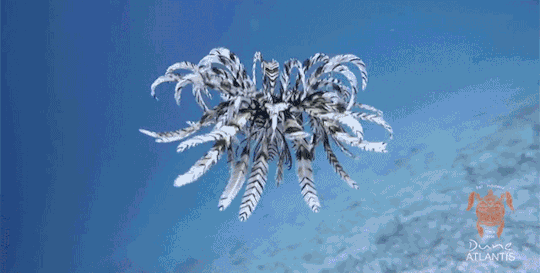
(gif id: a feather star swimming. It looks like a bunch of black-and-white striped feathers attached to a central disc. The arms are undulating, propelling the feather star through the water)
Crinoids are dioecious, meaning individuals are either male or female. In most species, the gonads are in the pinnules closest to the theca. The gonads actually swell up and cause the pinnules to burst and release the gametes. Different species have different strategies. In some, both sperm and eggs will be released into the water column. In others, only the males broadcast sperm which the females use to fertilize their eggs. The eggs are withheld by the mother, either by gluing them to her arms or incubated in sacs on the arms. The larvae, called vitellaria, are free-swimming and bilaterally symmetrical. They will swim for a few days before dropping to the substrate and attaching. They then metamorphose into juveniles.

(image: a diagram showing a crinoid progressing through multiple developmental stages from fertilized egg to larva. source)
The fossil history of crinoids dates back to the Ordovician period (485-444 million years ago), the period between the Cambrian and Silurian. While echinoderms and even stalked echinoderms existed during the Cambrian, the oldest definitive crinoid fossils are Ordovician and it's unclear which extinct group that crinoids evolved from. For over two hundred million years, crinoids were extremely diverse and were dominant sessile filter feeders, beating out anemones and corals. The mass extinction at the end of the Permian dealt a major blow to crinoids that they never recovered from, causing them to lose their dominance and become much less morphologically diverse. The Permian mass extinction is a fascinating period of history as it was the single greatest mass extinction in the history of Earth. The early Triassic saw a mass adaptation to more flexible and motile body plans in response to increased predation. It's not clear when feather stars entered the picture, though they may have come about due to predation in the Triassic. Some extinct crinoids had different survival strategies than modern ones. The genus Pentacrinites attached themselves to driftwood and floated through the open ocean. They would have been like floating islands of diversity moving through the oceans with lots of other animals following for food and shelter. A fact that gets passed around a lot is that the largest fossil crinoid ever found (Taxocrinus saratogensis) was 40 meters (130 ft) long. That isn't true and seems to stem from a misprint. It was actually 40 ft (12.2 m) long, which is still fucking enormous. Crinoids today don't get anywhere near as large as extinct ones could. Fossil crinoids measuring many meters in stem length are well documented while ones alive today never even reach a meter long. Crinoid fossils are extremely common and can be used to provide relative dates to nearby fossils. In some places, enough crinoid parts fossilized near each other that they became clustered together in sedimentary rocks called encrinites.

(image id: a fossil imprint of many crinoids attached to a piece of driftwood. The imprints ore in a flat, tan rock. The driftwood imprint looks like a long, dark blob. The crinoids have long, curved, and overlapping stems and fan-like crowns at the top. Fossil found at the Houston Museum of Natural Science)
#wet beast wednesday#crinoid#sea lily#feather star#echinoderm#paleontology#marine biology#biology#zoology#ecology#invertebrate
158 notes
·
View notes
Text
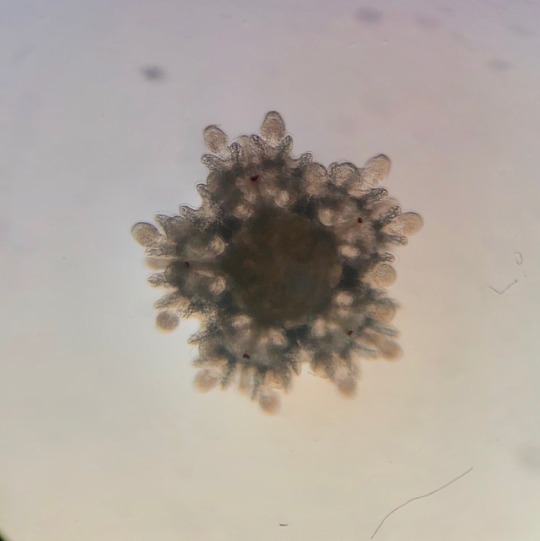



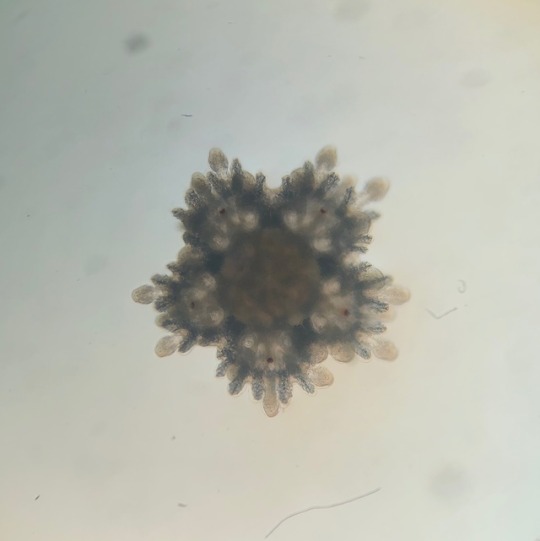

Starfish are beautiful little snowflakes!
These are some 20+ day old starfish larvae (Patriella exigua) under a compound microscope. They are each about 0.8 mm from ridge to arm.
Very cute, very sweet babies.
#personal#educational#starfish#sea stars#sea star#echinoderm#exhinodermata#microscope#microscopy#microscope images#electron microscope#micro#larvae#marine#marine science#marine biology#biology#marine life#science#stem
102 notes
·
View notes
Photo

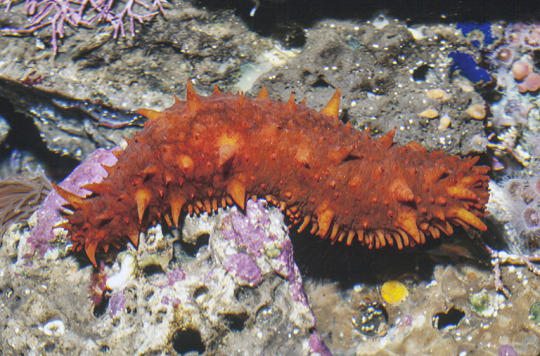



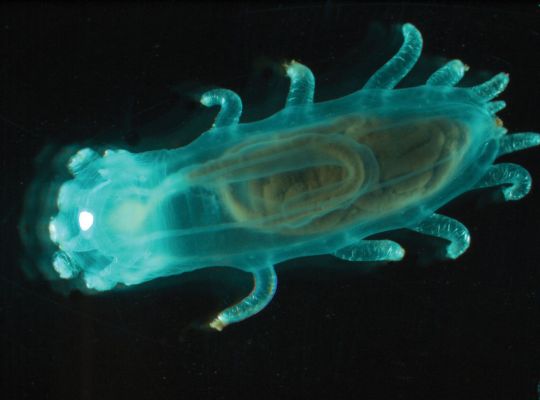
A Striking Salad of Sea Cumbers
No, they’re not a vegetable-- sea cucmbers make up the class Holothuroidea, which is a member of the echinoderm family-- invertebrates which also include star fish, sea urchins, and sand dollars. There are about 1,700 species of sea cucumber found on the ocean floor, in open water, and in coral reefs. These invertebrates are found all over the world, but the greatest variety of species can be found in the Asian Pacific, in reefs around Southeast Asia, Indonesia, and eastern Australia.
While they are invertebrates, sea cucumbers do have an internal skeleton: a structure made of tiny calcified branches called ossicles that are joined throughout the skin by connective tissue. Some species enlarge their ossicles to form hard plates, which can protect them from predators. Outside this common feature, sea cucumbers can take many forms. The stereotypical sea cucumber has a cylindrical body, often with bumps that resemble warts. These bumps have important functions ranging from locomotion to feeding, and in some species the bumps are elongated into tentacles. Most species also posses five pairs of tube-like feet. Outside the stereotype, however, members of the Holothuroidea class can take many forms, ranging from perfectly round to worm-like, and with many variations on appendages, location, and predatory defense. The average sea cucumber species range from 10 to 30 cm (4 to 12 in), but again there are many exceptions to the rule.
Holothuroidea has a relatively simple anatomy: a mouth, leading either to a stomach or the intestines, which empty into the anus. The anus is also used to filter oxygen from the surrounding water. As a defense mechanism, sea cucumbers may expel their organs through their anus when startled, and regrow them later. Other discharge a sticky mucus that ensnares predators. Many are toxic, and use bright colors and large appendages to warn potential predators away. However, some fish such as pufferfish, crustaceans, and large mollusks, have been known to make a meal of sea cucumbers when few alternatives are available. In turn, sea cucumbers feast on debris, plankton, and decaying organic matter. Most do this on the ocean floor, but some are able to swim or even ‘jump’ up to 1000m before floating slowly back down.
Like most echinoderms, sea cucumbers are not social; they largely ignore each other when they happen to occupy the same space. Different species can reproduce sexually, asexually, or both, and do so throughout the year. Most simply release thousands of sperm or ova into the open water, and these drift through the ocean until they combine to make a fertilized egg. The egg takes only three days to develop into a free-swimming larvae called the auricularia stage. Next is the doliolaria stage, in which the body enlongates and settles on or near the ocean floor. The last stage is the pentacularia, in which tentacles and tube-feet emerge. Once these features have finished growing, usually in a few months to a year, the sea cucumber are ready to reproduce.
Conservation status: Because of the large number and distribution of sea cucumber species, their status ranges from Not Threatened to Endangered. Their primary threat is over-harvesting for medicine or food. Many species on coral reefs are also threatened by habitat loss.
If you like what I do, consider leaving a tip or buying me a ko-fi!
Photos
White teatfish sea cucumber (Holothuria fuscogilva) by Steve Purcell
California sea cucumber (Parastichopus californicus) by Gerald and Buff Corsi
Transparent sea cucumber (Pelagothuria natatrix) by Larry Madin
Chocolate chip sea cucumber (Isostichopus badionotus) by NOAA
Leopard sea cucumber (Bohadschia argus) by Leonard Marks
Sea cucumber (Kolga hyalina) by Bodil Bluhum
#sea cucumbers#Holothuroidea#echinoderms#invertebrates#marine fauna#deep sea fauna#benthic fauna#pelagic fauna#coral reefs#atlantic ocean#indian ocean#arctic ocean#southern ocean#Pacific Ocean#animal facts#zoology#biology
178 notes
·
View notes
Photo
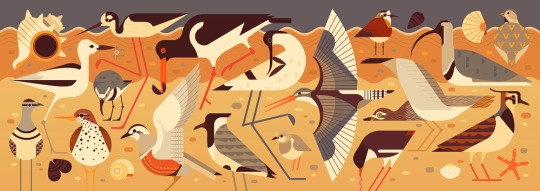
owen davey
1 note
·
View note